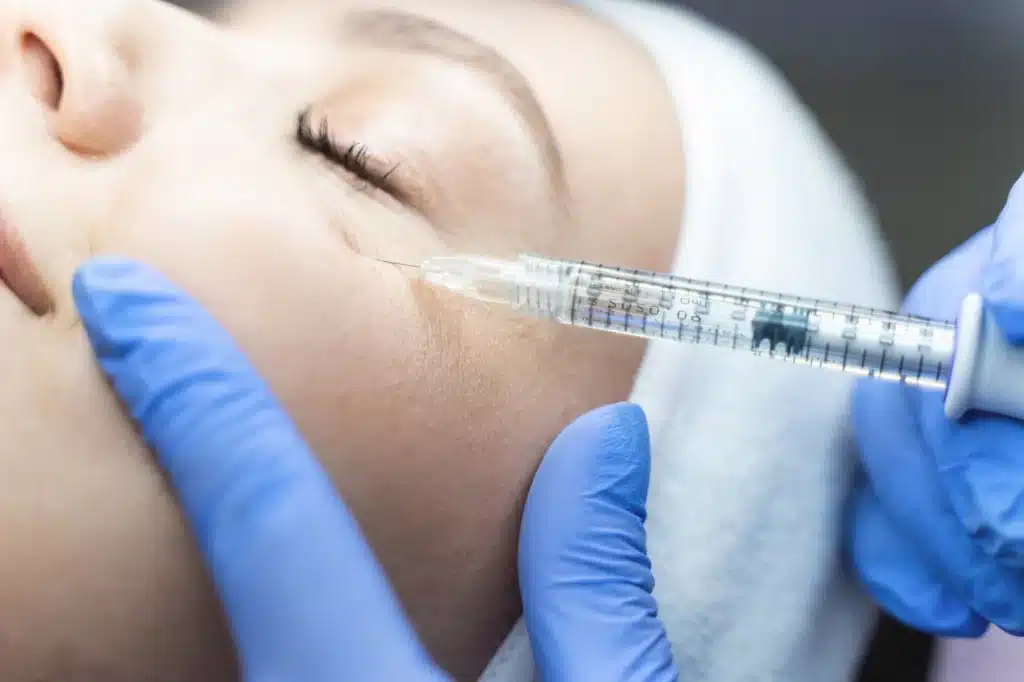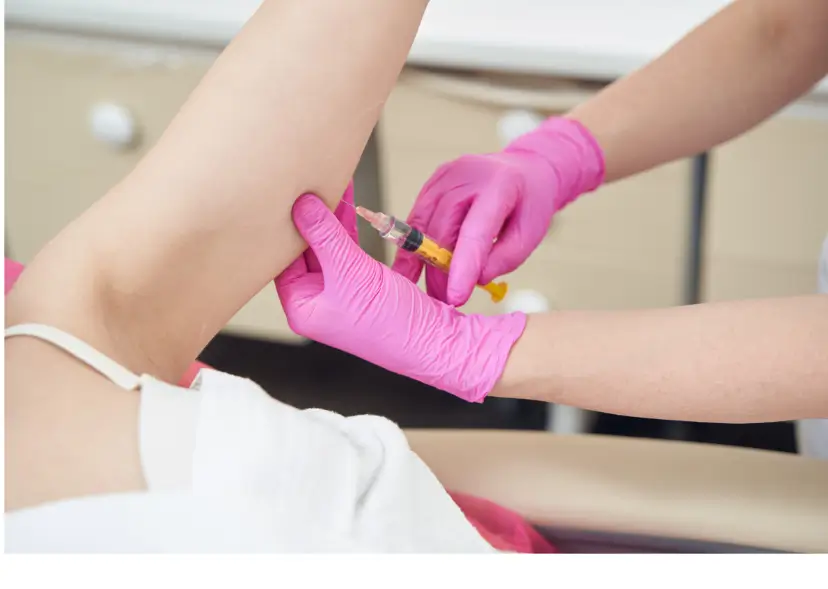Can you use Microtox under-eyes? This is a question that divides the medical spa industry. While not all medical professionals recommend treatments that include botulinum toxin type A applied on the facial areas, the diluted solution with microdoses proves to be an ideal alternative for patients needing a delicate boost. Hence, Microtox, a revolutionary approach to dermal injections, is rising in popularity among the target audience of people in their prime – as well as among doctors who administer it.
As all botulinum toxin type A products are quite potent, a professional approach is needed at all phases of the Microtox treatment. The microdose of the product is exactly what helps under eyes.
Key Takeaways
- Microtox is an innovative dermal injection approach, using botulinum toxin type A microdoses to target facial fine lines and wrinkles.
- Microtox is commonly referred to as baby BOTOX® or skin BOTOX®.
- Some of the benefits of Microtox include skin tightening and plumping, wrinkle reduction, and facial sculpting.
- Microtox is not recommended for treating under-eye bags and dark circles.
- Microtox can target fine lines around the eyes and crow’s feet.
About Microtox
Microtox refers to a treatment using microdoses of botulinum toxin type A or Microtoxin, a neurotoxin approved by the FDA (under the brand of BOTOX®, as one example). With uses in both medicine and cosmetology, botulinum toxin type A is known to relax muscles and fill in areas to minimize the appearance and the creation of wrinkles and fine lines, as well as for facial sculpting.
Now, with Microtox injections, medspa professionals can tackle finer skin requirements, which is why the treatment is often referred to as baby BOTOX® or skin BOTOX®. All the terms used for this procedure highlight the fact that it is perceived as a non-invasive, skin-boosting treatment.
Microtox Procedure
Microtox injections are an element of a microneedling procedure which, in contrast to BOTOX®, penetrates only the skin layers and not the muscle tissue.
The product used should be diluted, as suggested by a study published in the National Health Library:
Although a range of dilutions can give rise to excellent results, a final concentration of ∼20 U/mL is well-suited for treatment of the face. This concentration can be attained by reconstituting 100 U of BoNT-A with 5 mL of bacteriostatic saline or by adding 0.5 mL of 100 U BoNT-A in 2.5 mL saline to 0.5 mL of 0.5% lidocaine in a 1 mL syringe. Between 100 and 120 microdroplets can be delivered with each milliliter of solution, which is generally sufficient to treat the forehead, glabellar complex, or lateral canthal areas. To treat the entire face, 100 U in 5 mL is needed. To treat the lower face and neck, a slightly more concentrated solution of 28 U/mL is recommended for each side (total 56 U).
Then, as with any other microneedling procedures, Microtox facial injections are applied to the skin, allowing for the product to achieve the best possible results: ones that will make both the cosmetologist and the patient happy.
What Are the Microtox Benefits?
Microtox treatments are becoming popular due to their numerous benefits and the fact that the procedure offers subtle results that can be equated to the appearance of naturally refreshed skin. The effect of Microtox treatments lasts about three months and, if needed, can be repeated to maintain the results.
Microtox skin tightening is the number one benefit clients turn to medical professionals, while other benefits of this technique include:
- reduced or eliminated wrinkles and fine lines
- decrease in pore size
- improved skin texture
Do note that under-eye bags and puffiness are not one of the aesthetic reasons to opt for a Microtox technique, as the treatment can affect the natural drainage of the under-eye muscles.
Microtox for Under Eye Area: Treatment Evaluation
Studies and experience prove that Microtox can be applied under the eyes, just as it can be used on other facial areas with thin, delicate skin.
The key to under-eye Microtox procedures is in the adequate application of the rightly diluted solution, done only by trained medical professionals with years of experience with dermal injections. As some doctors will decline using BOTOX® in under-eye muscles, believing the procedure is not the best answer for how to treat under-eyes, the alternative of Microtox with its benefits may be more achievable for patients.
That said, medical history and patient’s requirements for this procedure need to be taken into consideration. Always thoroughly consult with your client before the procedure and advise on any possible side effects. Treatment frequency depends on the individual, but Microtox is usually administered every three to four months.
Microtox Under Eyes Side Effects
Studies show that some of the common side effects of the Microtox procedure can include:
- Minor bruises
- Asymmetries
- Reduction of muscle movement in the applied area.
These are all seen to pass in a matter of hours or a few days and may result from the application process going deeper into the skin area.
Other effects of the Microtox are similar to other dermal injections, like:
- Redness
- Skin irritation or allergic reactions
- Itchiness, pain, or uncomfortable sensations in the area of application.
When done correctly, Microtox facial injections should not impose any discomfort lasting longer than expected for cosmetic treatments. Post-procedure recommendations are no different than usual BOTOX® aftercare: patients are always advised to rest for a few days after the treatment and to refrain from other facial treatments for about two weeks.
What Is the Best Toxin for Microtox Under-eye Treatment?
Traditionally, toxins like BOTOX® COSMETICS, XEOMIN®, and BOCOUTURE® are injected into the muscles, creating a more visible effect targeting more significant imperfections. Microtox uses dilution and microdoses of these products for shallow skin injections, resulting in reducing fine lines and giving the skin a little boost of a youthful appearance. And, as opposed to direct botulinum toxin type A, it can be used as a fine line under eye treatment.
Toxin choice is a matter of preference, but ensure you get authentic products from reliable wholesalers like Medical Spa Rx.
Conclusion
Microtox under-eye treatment is becoming a popular solution for reducing fine lines and crow’s feet. However, it is not recommended as a solution to dark circles or under-eye bags.
By needing only microdoses of botulinum toxin type A and penetrating top skin layers, Microtox is a delicate solution with effects lasting for about three months for all those looking to give their appearance a refreshed look.
Explore the range of botulinum toxin type A brands at Medical Spa Rx.
FAQ
Is it OK to put BOTOX® under eyes?
Depending on your patient’s desired effect, you can use BOTOX® under eyes.
How long does Microtox last?
The results of Microtox last about three months, with some patients showing a long-lasting effect of up to six months.
What is the difference between Microtox and BOTOX®?
Microtox uses microdoses of BOTOX®, dilutes it, and then injects it into the skin layer, rather than the muscle.
What is the Microtox technique?
The Microtox technique involves using microdoses of botulinum toxin type A in order to reduce fine facial wrinkles.
How much BOTOX® for Microtox?
The exact measurement of BOTOX® used in Microtox procedures depends greatly on the area treated and the desired effect.
References
Nigam P, Nigam A. Botulinum toxin. Indian Journal of Dermatology. 2010;55(1):8. doi:https://doi.org/10.4103/0019-5154.60343
Green DM. BOTOX® Under Eyes, Under Eye Bags & Dark Circles. Dr. Michele Green M.D. Published September 20, 2022. Accessed February 11, 2024. https://www.michelegreenmd.com/botox-under-eyes#:~:text=While%20botox%20has%20been%20specifically
Fabi SG, Park JY, Goldie K, Wu W. Microtoxin for Improving Pore Size, Skin Laxity, Sebum Control, and Scars: A Roundtable on Integrating Intradermal Botulinum Toxin Type A Microdoses into Clinical Practice. Aesthetic Surgery Journal. Published online March 1, 2023. doi:https://doi.org/10.1093/asj/sjad044





















